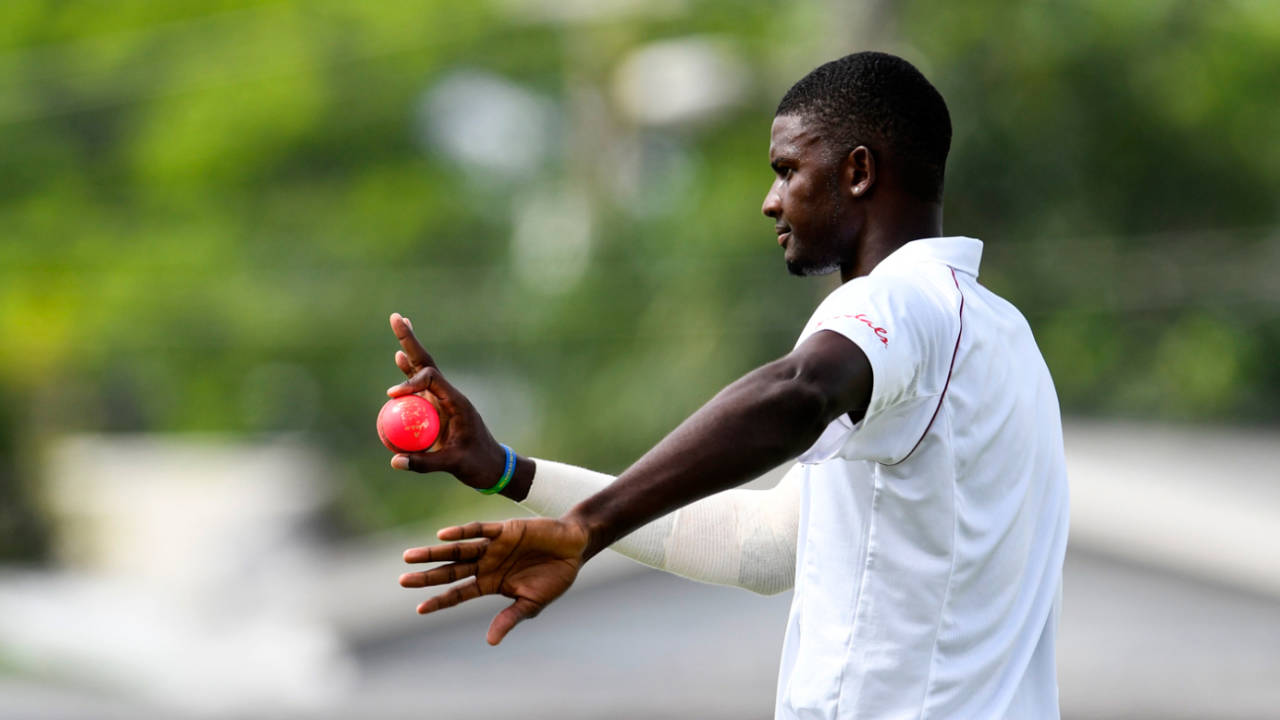Holder, Gabriel and Russell the stars of WI's home season
Although West Indies faltered in the limited-overs formats, these three players showed signs of better days ahead
Shashank Kishore
07-Aug-2018
Jason Holder directs a field change • CWI Media
It is an anomaly that West Indies' red-ball form trumped their white-ball showing across a home summer; the last time they ended two Test series without losing either was as far back as in 2000, when they still had the likes of Carl Hooper, Shivnarine Chanderpaul, Courtney Walsh and Curtly Ambrose in the mix.
But that is exactly what happened in 2018 as West Indies drew with Sri Lanka 1-1 and beat Bangladesh 2-0 in the longest format, but lost both the ODI and T20I series against Shakib Al Hasan's men. They couldn't win a place in the Champions Trophy last year. They were asked to qualify for the World Cup. There are enough signs that their limited-overs cricket needs fine-tuning, but taken as a whole, West Indies' performance in the home summer was quite encouraging.
The captain comes of age
For the first three years since his elevation to captaincy in 2014, questions over Jason Holder's place in the side - much like of his predecessor Darren Sammy - weren't uncommon. He was a workhorse, no doubt, but where were the wickets? He could play all the shots, but didn't have runs consistently to back-up the natural ability. Was his role in the side unclear? Would he be playing if he wasn't captain?
He answered these questions emphatically for the first time in Sharjah in October 2016 against Pakistan, with a match-turning maiden five-for in the second innings as West Indies clinched a remarkable win (one tailored equally by Kraigg Brathwaite, who remained unbeaten in both innings). Holder's bowling average leading into that Test was 46.61. But since April last year, and among those who have at least 50 Test wickets, Holder's average of 22.14 is the fourth-best.
His 28 wickets so far in 2018 are the most he has picked up in a calendar year. Holder's wrist-position and ability to curl the ball both ways has come in for special praise from Ian Bishop. That 57.14% of these wickets were either bowled or lbw demonstrate an improved accuracy and ability to build pressure. Holder will have four Tests in the subcontinent later this year (three in India, two in Bangladesh) to further reinforce his bowling credentials.
His batting too came of age. Apart from picking up 12 wickets in the Sri Lanka series, his contribution with the bat in Port-of-Spain made a huge difference. His 90-run stand for the sixth-wicket with Shane Dowrich arrested a slide as West Indies recovered from 147 for 5 to declare on 414 for 8. This allowed them to take a 229-run lead, one that eventually turned out to be match-winning. Now, his batting and bowling averages are on the right side of 30, progress he credits to then-selector Clive Lloyd.

Gabriel records best figures in West Indies•ESPNcricinfo Ltd
Shannon Gabriel breathes fire
Bangladesh's bowling coach Courtney Walsh, sitting in opposition, could have been forgiven for shedding a tear of joy watching Gabriel invoke 'oohs' and 'aahs' from the Sabina Park crowd during the second Test.
First session or final session, Gabriel frequently breached the 145kph-mark. The pace and that mean short ball made for a heady cocktail. Since 2017, he has 62 wickets at 22.82. Thirteen of those wickets came in the St Lucia Test, where he recorded the best figures ever in the Caribbean. Overall, only two other West Indies bowlers - Michael Holding and Walsh - have managed better figures.
Some part of this second coming can be put down to increased fitness and better awareness of his body, something Gabriel admits wasn't the case until 2016. The injury on the tour of Australia in 2015, he says, proved to be the turning point. Such was his intensity and rhythm during the Tests that Bishop, on commentary, felt West Indies could do with him even in the shorter formats. The only concern in his bowling at the moment: the big no-balls, not unusual for a bowler who prides himself on being menacingly quick.
Andre Russell is back and firing
"Even if I'm 95% fit, I want to be up and running for West Indies. Playing for the country is far different to winning with your T20 franchises." Having missed cricket for a year for a doping-code violation, Russell wants to make up for lost time. He's been part of two World T20-winning squads and five championship-winning T20 franchises (Kolkata Knight Riders, Islamabad United, Sydney Thunder, Jamaica Tallawahs and Dhaka Dynamites), and has made no bones about wanting to play a similar role for West Indies at the 2019 World Cup.

Andre Russell muscles a ball for a maximum•Getty Images
Hamstring and knee problems forced him out of the two ODIs against Bangladesh, but his return for the T20Is that followed showed that they were just niggles. As did his hitting those big sixes and bowling at high pace.
Russell had a new role in the series as well, batting at No. 3. Most teams have been reluctant to have him so high up the order but the merit of this ploy became immediately apparent. In the first T20I, with West Indies 10 for 2 in a truncated chase of 91 in 11 overs, he waltzed his way to a quickfire, match-winning 35 not out. And in the decider, his 21-ball 47 breathed life into a dead game and had a resurgent Bangladesh suddenly grappling with bowling headaches.
Russell at No. 3 is an option West Indies should look at in ODIs as well, according to Bishop. "It's a left-field move which I hope the team management considers," he said on commentary. "It may not happen, but it's definitely more than worth a thought."
Shashank Kishore is a senior sub-editor at ESPNcricinfo
